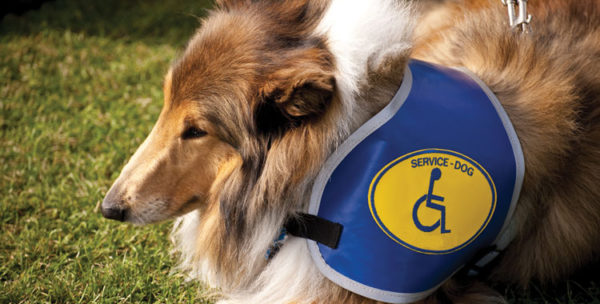Service Animals in the Workplace: What’s Required, What’s Not?
by BusinessWoman magazine / 0 Comments / 2258 View / May 31, 2018
Office pets have become more common in the workplace. But where do service animals fit in?
These are defined by the Americans with Disabilities Act as “any dog that is individually trained to do work or perform tasks for the benefit of an individual with a disability, including a physical, sensory, psychiatric, intellectual, or other mental disability.”
Separately, the Title III regulations from the Department of Labor include miniature horses in DOL’s definition of service animals.
Must employers allow employees with disabilities to use service animals in the workplace?
The ADA does not specifically address service animals but does so in the context of places of public accommodation, said Sara Myirski, Buchanan Ingersoll & Rooney, PC.
These two are distinguishable, but because most workplaces can be considered places of public accommodation, employers should be prepared to address any employee requests for a service animal as they would any other request for reasonable accommodation.
Apart from the ADA requirements, employers in Pennsylvania should be aware that a state law criminalizes discrimination related to service animals. The law provides, in part, that employers cannot refuse access to a guide, signal, or service dog or other animal that has been certified by a recognized authority to assist a person because of physical disability, blindness, or deafness.
May employers provide other accommodations instead of a service animal?
They may, but it depends, said Myirski. Disabled employees are entitled to a reasonable accommodation but not to the accommodation of their choosing. This goes back to the requirement that employers engage in the interactive process with employees.
The employer may suggest alternatives to the use of a service animal, particularly if the use of a service animal would constitute a direct threat to the health and safety of others in the workplace. This concern frequently comes up in workplaces governed by strict sanitation rules, such as the food-production or healthcare industries.
Moreover, DOL regulations provide that a place of public accommodation may ask if the animal is required because of a disability and what work or task it has been trained to perform.
Are certification, vaccination, and proof of insurance required?
They may be requested, but not required.
Certification for service animals is sometimes not available, even when provided by training groups.
Vaccinations are tricky because the employer is not always qualified to determine what vaccinations are suitable.
Regarding insurance, the best practice for employers is to ask for documentation that the service animal is required because of a disability and performs a task related to the disability.
The employer may also request that the employee bring the animal in to demonstrate its training and its lack of disruptiveness.
If employers must purchase additional insurance to have pets on their premises, who is responsible for that cost?
The ADA doesn’t specify, but employers should be prepared to bear the cost.
May an employer deny a request to bring a service animal to work if there are areas of the workplace it cannot go?
That depends on the employee’s facilities. In some cases, there can be ways the employer can accommodate the request and limit access to certain areas. Alternatively, the employee may leave the service animal in the unrestricted area of the facility.
In other cases, however, the burden on the employer may be too great — as in the case of a direct threat to the health or safety of others.
In determining when there is a direct threat, the employer must consider the “nature, duration, and severity of the risk; the probability that the potential injury will occur; and whether reasonable modifications of policies, practices, or procedures or the provision of auxiliary aids or services will mitigate the risk.”
What are employers allowed to tell co-workers about an employee with a disability bringing a service animal into the workplace?
This is something the employer should first discuss with the employee. The employee may wish to inform his or her co-workers about the service animal and the task(s) it performs.
Sometimes, however, the employee may not want to discuss it. Generally, the employer may inform co-workers, but employees should not interact with the animal.
What if another employee is allergic to the service animal?
In such cases, the employer should be prepared to try to accommodate both employees. The essence of reasonable accommodation requires flexibility from all parties, which may mean trying to place the employees in different areas of the facility, setting paths of travel for each employee, limiting in-person communications, and modifying work schedules.
Who is responsible for the care of a service animal?
It is solely the responsibility of the employee. A service animal may be excluded from the workplace if it is out of control or isn’t housebroken.
An employer may require that employees adjust their break times to care for their service animal. Employers must be prepared, however, to allow periodic breaks so the employee can tend to the animal’s needs, including periodic bathroom breaks, provided such breaks don’t impose an undue burden on the employer’s operations.
Are emotional-support animals the same as service animals?
Not exactly, said Myirski. Emotional-support animals may be merely companions. In some cases, however, they may qualify as service animals. The distinguishing feature is the training the animal receives.
If the animal is trained to do a specific task to address a disabled individual’s needs, it is a service animal, even if it is to provide comfort.
For instance, emotional-support animals may be trained to warn a person with severe anxiety of an impending attack and comfort the individual to either alleviate or prevent the attack. BW
Disclaimer: The responses are for educational purposes only and shouldn’t be considered legal advice.


Your Commment
You must be logged in to post a comment.